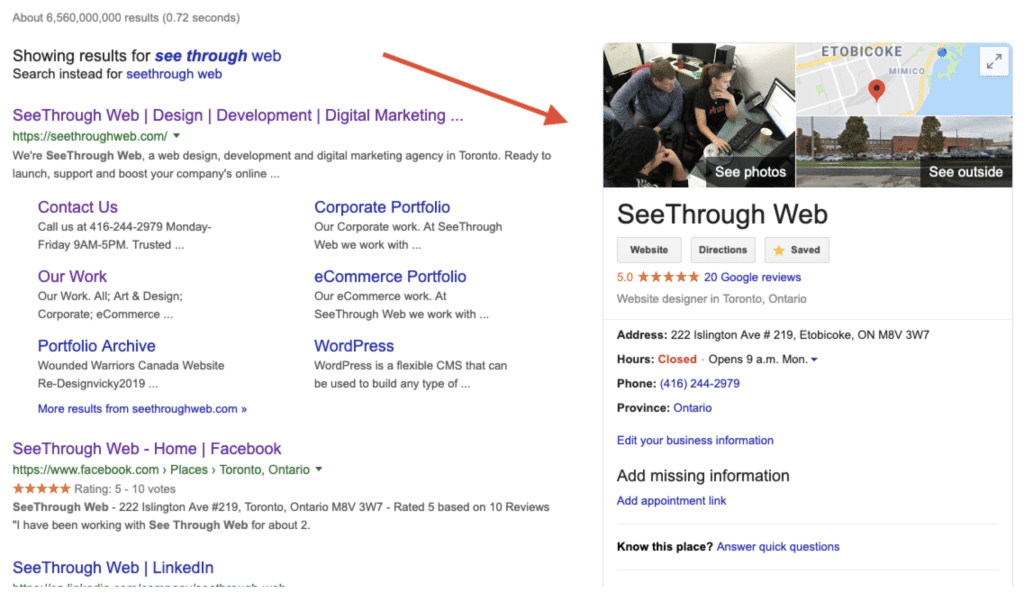Whether you’re launching a new business or you’ve been in business for a while, these tips will help to ensure your website is working as hard as it can to bring you new business.
Here’s our list of 6 things every business can do to get more business through the web.
1.- Get Google on your side
Setup, if you haven’t already, a Google My Business account. It’s a free tool that has a lot of options, including:
- Giving Google your location information, so your site has a greater chance of showing up for people who are near your business
- Displaying that panel on the right side of google searches, which contains your business information, including a map to your location, the “directions” button, possibly your hours, pictures of your business, and more.
- Allowing people to provide reviews of your business, which just about everybody looks at these days.
As a bonus, once you have this set up Google will start sending you monthly reports about how many people viewed that panel and clicked on the various buttons (get directions, call, website, etc.).

2.- Setup Google Analytics and Google Web Console
These are two separate tools that provide a lot of insight into how people interact with your website, including:
- How did they get to your website? What site did they visit before coming to yours? If they searched and found you, what did they search for?
- What parts of your website are they viewing?
- If you have an eCommerce store, how far are they getting down the purchasing path, and where are they dropping off?
- Is Google able to read your site? Is it scanning and indexing all of the pages of your site, or is it having trouble somewhere?
Doing your own SEO?
There are some excellent seo plugins for WordPress. We typically use Rankmath or Yoast. When you’re editing a page in WordPress they give each page a score and provide feedback about how to improve its seo.
If you want an independent tool for digging deeply into your site or your competitors sites check out SEM Rush.
3.- Website Health and Speed
Look at your website with a critical eye. New customers are going to be more likely to connect with you if they have a seamless experience on your website.
- How long does it take to load? Under 3 seconds is great. Between 3 and 5 seconds is ok. More than that you may want to look at what is slowing it down. If its slow, are there images that could be resized and optimized (that’s often a culprit), is it the hosting, or is it something else? eCommerce sites tend to be a bit slower, but maybe there are still things that could be done to boost the performance.
- Do you have any dead ends or broken links?
- Let’s not forget about mobile. These days a huge percentage of website views are taking place on phones and tablets. Whenever possible, make your site’s mobile version as fast and light as possible.
4.- Optimize your site for the search engines (Google, Bing, Yahoo)
Search engine optimization today is more than just adding a few keywords here and there.
Think as a searcher, what is your frame of mind and what would you search for to find your type of services or products?
How would you search for it using different devices (laptop vs phone)? Is there enough content on your website that tells what you do and establishes credibility for people to make an informed decision or purchase?
5.- Tell people about your business!
Create social profiles for your business. Posting regularly to social media is great, but even if you just want to take advantage of the advertising capabilities of the social platforms, you need to have a profile on those sites. That profile, by the way, should also contain basic information about your business – name, location, contact information, etc.
Depending on your business, some social media sites will be more helpful than others.
- Instagram is great for businesses such as restaurants, retail, travel, or any other where you want to show people what your business is about.
- Twitter works great for businesses that need to keep their customers updated, like magazines or other publications.
- Facebook is great for shops, either online or brick and mortar.
A targeted ad campaign in the right social channel can get your business in front of your ideal customer.
6.- Local Search
Lastly, it’s not all about the big players – Google, Instagram, Facebook, etc. There are many local business directories that people reference when looking for products or services. Take some time and ensure that your business is listed where people are looking. Track these too and make sure that your information is the same across platforms. We’ve often come across business that have different address information in different directories. That’s just confusing!
It’s also possible to add your business information to vehicle GPS systems (Ford, BMW, etc.). This can be very handy if you’re a restaurant, medical office, or any business where customers come to your physical location.
If you’d like help with these or anything else related to your website, social media, SEO, or just getting business online in general, feel free to reach out.
GTMetrix provides an easy to use tool for checking your website’s speed and makes recommendations for things that can improve it.
Doing your own SEO?
There are some excellent seo plugins for WordPress. We typically use Rankmath or Yoast. When you’re editing a page in WordPress they give each page a score and provide feedback about how to improve its seo.
If you want an independent tool for digging deeply into your site or your competitors sites, check out SEM Rush.

